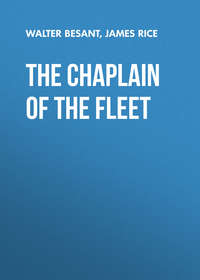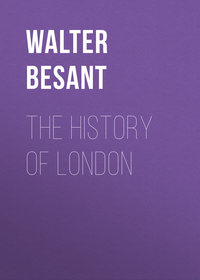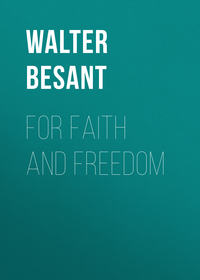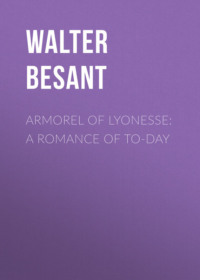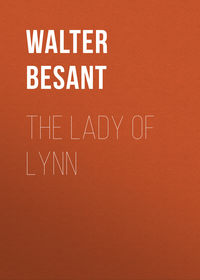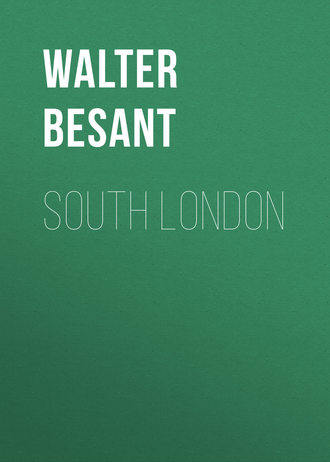 полная версия
полная версияSouth London
I have mentioned Winchester House, the Palace of the Bishop, as being close to the Priory. On any map may be traced the extent of the Palace. On the north is Clink Street, the Clink Prison being at the west end of the street; on the west is now Park Street, formerly Deadman's Place; on the south is a continuation of Park Street; and on the east is a street running south from St. Mary Overies Church. Winchester House, which thus covered a large piece of ground, was, with its grounds, enclosed by a wall. Many of the buildings, especially the great gate, remained standing almost within the memory of man. The state and ceremony of a Bishop demanded a large retinue, and the Bishop's house must therefore be provided with a sufficient number of rooms for their accommodation. The map must not be accepted as laying down the exact site, the distances or the scale, or the arrangement of the courts and buildings.
We have now to speak, but briefly, of the Marian Persecutions and of the Martyrs. With these the Church of St. Mary and Winchester House had a good deal to do.
On Monday, January 28, 1555, was seen the first of many melancholy sights. On that day Gardiner, Bishop of Winchester, presided at a Court held in St. Mary Overies Church for the trial of heretics. The court was actually held in the Ladye Chapel. Hither were brought Bishop Hooper and John Rogers: they were heard: they argued their case: they were found obstinate: they were committed to the Clink Prison hard by: on the next day, with Bradford, Dr. Crome, Dr. Saunders, Dr. Ferrar, Dr. Taylor, and several others, they were sentenced to be burned. Bradford wrote to Cranmer after the trial: 'This day, I think, or to-morrow at the uttermost, hearty Hooper, sincere Saunders, and trusty Taylor, end their course and receive their crowne. The next am I, which hourly looke for the Porter to open me the gates after them, to enter into the desired rest.'
So began those fires from which the cause of Roman Catholicism long suffered, and is even now still suffering. For the popular judgment does not discern and separate. The burnings under Henry and Edward are lumped together in the mind of the people, and all set down to Mary. The names, places, and times of the martyrs and their martyrdoms as given by Machyn, not by Fox, show that if the Queen's advisers had deliberately done their best to make their form of Faith odious and hateful, they could not have devised a better plan than the burning of the people for religion's sake. It is generally thought and believed that the indignation of the people was aroused by seeing the Bishops and preachers burned. That I do not believe. The executions of great men do not affect the populace; they witness the passage of a Thomas More on his way to the block: or of a Cromwell: with equal indifference: these statesmen do not belong to the life of the people. In the Marian persecution they heard that Archbishop Cranmer had been burned at Oxford, but they offered little outward show of emotion: they heard that Ridley and Latimer had been burned: their constancy, no doubt, touched the crowd: but still, these martyrs were not of themselves. When, however, they found that not only Bishops and great people, but also their own brothers, cousins, fathers, were taken out from their workshops and tied three or four together to the stake, where they suffered the agonies of the fire and still continued to pray aloud with firmness: then the lesson went straight home to them; and for many a generation to come the people learned to loathe the very name of the religion which could thus burn innocent people by the hundred for believing, as they were told, what the Bible taught.
It is a mistake, again, to suppose that the lessons of persecution were taught at Smithfield alone. They were industriously taught from many centres. There were burnings at Stratford-le-Bow: at Stepney: at Westminster: beyond St. George's, Southwark, at Newington; while the vast crowds which attended a burning and imbibed these lessons of fear and hatred are shown by two entries alone in Machyn's Diary, 1556. 'The xxvij day of June rod from Newgate unto Stratford-a-bow, in iii cares xiij, xj men and ij women, and there bornyd (burned) to iiij postes, and there where a xx M pepull.'
And again, 1556. 'The xxij day of January whent in to Smythfield to berne between vii and viij in the morning v men and ij women: on of the men was a gentyllman of the endor tempull, ys nam Master Grén; and they were all bornyd by ix at iij postes. And ther wher a commonment throughe London over nyght that no young folke shuld come ther, for ther the grettest number was as has byne sene at swyche a tyme.'
Therefore it is evident, first, that enormous crowds gathered together to witness the sufferings of the victims, and to note their constancy in the hour of agony; secondly, that the authorities were becoming alarmed at the effect which these examples might have upon the young. No young people were permitted to be present. We may be sure that the prohibition was openly defied.
As for Gardiner, he died soon after the martyr fires began, stricken, said his enemies, by the hand of God in punishment for his cruelties. His physicians, I believe, called it gout in the stomach, a reading which one prefers, because Gardiner was no worse than the rest of them, and after his death there was no abatement, but rather an increase, in the burnings. He had, however, a very fine funeral, which began at the church of St. Mary Overies, and was continued all the way to Winchester, where the place of his burial and his Chantry Chapel may still be seen.
Of this function, Machyn gives a short account, but it shall suffice. It must be remembered that Gardiner was not only a very great person, but that he was also believed to be the natural son of Bishop Woodville, and, if the belief was well founded, he was therefore a cousin of the Queen. But this may be scandal. Machyn, the chronicler of funerals, thus describes Gardiner's funeral.
'The xxiiij day of Feybruary was the obsequies of the most reverentt father in God, Sthevyn Gardener, docthur and bysshope of Wynchastur, prelett of the gartter, and latte chansseler of England, and on of the preve consell unto Kyng Henry the viij and unto quen Mare, tyll he ded; and so the after-none be-gane the knyll at sant Mare Overes with ryngyng, and after be-gane the durge; with a palle of cloth of gold, and with ij whytt branchys, and ij dosen of stayffe-torchys bornyng, and iiij grett tapurs; and my lord Montyguw the cheyffe mornar, and my lord bysshope of Lynkolne and ser Robart Rochaster, comtroller, and with dyvers odur in blake, and mony blake gownes and cotes; and the morow masse of requeem and offeryng done, be-gane the sarmon; and so masse done, and so to dener to my lord Montyguw ('s); and at ys gatt the corse was putt in-to a wagon with iiij welles all covered with blake, and ower the corsse ys pyctur mad with ys myter on ys hed, with ys armes, and v gentyll men bayryng ys v banars in gownes and hods, then ij harolds in ther cote armur, master Garter and Ruge-crosse; then cam the men rydyng, carehyng of torchys a lx bornyng, at bowt the corsse all the way; and then cam the mornars in gownes and cotes, to the nombur unto ij C. a-for and be-hynd, and so at sant Gorges cam prestes and clarkes with crosse and sensyng, and ther thay had a grett torche gyffyn them, and so to ever parryche tyll they cam to Wynchaster, and had money as many as cam to mett them, and durge and masse at evere logyng.'
The Church, when the Priory was dissolved, stood on the south side of the monastic buildings: the Cloister occupied that part of the ground on the north of the nave: the refectory, chapter house and dormitories, and other buildings stood about the Cloister: an embankment kept off the Thames at high tide: on the west side was St. Mary Overies Dock, which was also the south end of the ferry. The dock is there still, but where the wall of the Monastery stood, round the Garden, and one could see the orchards beyond, are now huge warehouses. Some remains of the Cloister stood until recently, and one gateway of the precinct – there was certainly another on the side of the High Street – stood close to the west front of the Church. The Cloister received the name of Montagu Close, after the son of Sir Thomas Brown who became Viscount Montagu. If you pass round to the north of the Church you will now find a few fragments piled up, the indication of an ancient door in the wall of the Church; but all traces of the monastic buildings are entirely swept away.
The ground in front of the Church is also changed. In post-Reformation times there was a school here – St. Saviour's school; there were also almshouses; there was a peaceful quiet kind of close, in which was heard the buzz of the boys in school; one saw the bedesmen creeping along in the sun; one watched the crumbling ruins falling fast into decay: one wondered where in the narrow churchyard or in the Church lay the bones of Massinger and Fletcher: one seemed to see Bishop Hooper and John Rogers stepping forth into the sunlight, their trial over, their sentence passed: their cheeks, perhaps, somewhat flushed, their eyes somewhat brightened, because, even with such a faith as theirs, all a man's courage must be wanted to face the agony of the flames, through which for half an hour they would have to wade, as Christian waded through the river, before they reached the shore beyond.
CHAPTER XI
THE SHOW FOLK
Southwark was a city of a various population. It had great Houses for nobles and for Ecclesiastics: it had fair inns for the reception of merchants, coming up from Kent and the south country: it had a riverside people of fishermen and watermen living up stream on the Lambeth bank or down stream at Bermondsey or Rotherhithe: it had a great number of residents who worked in the orchards and the gardens which spread over the whole of the rich low-lying land now embanked, secure from floods and the highest tides. It contained, besides, a large number of rogues and vagabonds, fugitives from justice, lying here in so-called sanctuary, where the officers of the law did not dare to present themselves. In spite of the powers granted to the City over Southwark, the place remained a receptacle and a refuge 'down to the end of the last century, when the so-called Liberties of the Mint' – the last place of sanctuary – were finally abolished and only a slum remained to mark the site of a sanctuary.
Beside all these people Southwark contained the Show Folk of Bankside. When the Show Folk began to live in Bankside I know not: their settlement originally was in Westminster outside the King's Palace, where there was always a great demand for music, dancing, tumbling, mumming and such recreative performances; they were also, however, in great request in London by City Church, city company, and city tavern. Now there was no place for them within the walls: they had no company: there was neither a Musicians'; nor a Dancers'; nor a Singers'; nor a Mummers'; nor a Tumblers' Company. There was no company which would admit them; there was no ward where they could get a street for themselves: they were gently but firmly pushed out. And not only were they a class apart but they were a class in contempt. It was always held contemptible to provide amusement. No one, as yet, had made of music or of acting a fine art; no gentleman, as yet, and for a long time after, would take part in the buffoonery which the actor had then to exhibit: an atmosphere of disrepute attached to the calling, to those who followed the calling, and to the place where they lived: in the City, Aldermen had a way of connecting nocturnal disorders with these children of melody: where they resorted the taverns would carry on their revelries after curfew, even to midnight: if the street was alarmed by nocturnal ramblers it would prove to be after an evening with the dancers and the tumblers: the Church, especially the Church Puritanic, set her face against those who devised entertainments, on the ground that the devisers were an ungodly and dissolute crew. Therefore they crossed the river. On Bankside, in the Liberty of the Clink, where the City could not interfere, they 'went as they pleased.' They were dissolute, if they chose – Heaven knows whether they did choose – without reproach: their taverns kept open house as long as they would stop to drink: there was singing every day without interference: there was merriment without the rebuke of the sour face: there was no fear of being haled before the Lord Mayor, for making people laugh: there was no terror of pillory, and no man on their side of the river was 'put in stocks o' Monday, for kissing of his wife o' Sunday.' It was the Bishop of Winchester's Liberty, but he was content, on the whole, to leave the residents unmolested and in the possession of their guitars, their fiddles, their songs and their plays.
When the Show Folk were wanted in the City it was easy for them to go across: they were ready at a moment's notice to arrange a pageant, or to take part in one: they could provide the beauteous maidens in white with long fair tresses who stood on platforms in Chepe and scattered gold rose nobles made of paste on the heads of the crowd: they found hermits, and constructed caves for those godly men in the midst of Gracious Street: they found the music for the dragging of the traitor on a hurdle: for the march of the rogue to the pillory: for the riding of the Lord Mayor: for the procession of the Company on its feast day. For a miracle play they presented the parish church with the Fall of Man: the Raising of Lazarus: the Pilgrims of Emmaus: David and Goliath: or any other episode from the Bible – how many excellent players there were among them whose names have long since been forgotten! They knew how to present a Masque – not, perhaps, with the same splendour as one by Ben Jonson and Inigo Jones – who commanded the King's purse – but a neat and creditable affair, with dresses appropriate, full of surprises, and furnished with mythological characters, for the Hall of a City Company on the day of the Annual Feast. For young gentlemen of the more debauched kind they had another kind of entertainment, with singing, dancing girls, tumbling and posturing; with rare jests – pity they were not rarer – and excellent fooling by their clowns. The modern art of acting did not begin at the Globe Theatre: there has never been any time when the actor was unknown: the only difference is that he was not formerly allowed to be anything but a buffoon: that he had little but buffoonery in his répertoire: and now he is an artist and scorns the tricks of the buffoon. Nor is the art of entertainment of modern invention. The Company of Parish Clerks, for instance, were great promoters of sacred plays. Their poets – whose names are entirely lost – provided the words and arranged the scenes; the members of the company played the parts: the Show Folk 'mounted' the piece: they provided the monsters; the red flames for the mouth of Hell; the troops of angels or of devils, the stage business and the music. Many of the Parish Churches had their annual play on their Saint's Day. Thus the Parish Church of St. Margaret, which was taken down when St. Mary Overies' became St. Saviour's, had its play on St. Margaret's Day (July 20), and often another on the Day of St. Lucy (December 13) as well. We have already observed that the Londoner of old never made any difference in the matter of Play or Pageant whether the time was summer or winter. He was like the Scythian, face all over: he felt no cold: he held his Riding, or his Coronation Procession, quite as readily in December as in July.
Another kind of Show Folk, but rougher and more brutal, were the people who looked after the bears and the dogs. Bull baiting, bear baiting, sometimes horse baiting, together with badger baiting, duck hunting, cock throwing, dog fighting and cock fighting, were the chosen and common sports of the people. Baiting of every kind there was wherever there were dogs and bulls and badgers, but the centre and headquarters of the sport was South London, in the place called Paris Gardens. The popularity of the sport is shown by the simple facts that there was not only bull and bear baiting in Paris Gardens, but also two rings or amphitheatres for bull and bear baiting outside the gardens behind Bankside, and that in the High Street itself, nearly opposite St. George's Church, there was permanently established the bull ring to which an animal could be tied whenever one was found fit for the purpose of affording an hour's sport by the madness of his rage or the agonies of his death.
The present Blackfriars Bridge Road cuts through the site of Paris Gardens, leaving a portion on either side. They extended to the distance of about a quarter of a mile south of the river: sluggish streams and ditches ran across and round the gardens, which were so thickly planted with trees as to be dark in the summer. Both in summer and winter the place was noisome with exhalations from the marshy soil. These gardens were the chief home of the rough and cruel sports already mentioned: here were kept under the King's bearward the King's dogs; the Mayor's dogs; and the bears whom they baited. It does not appear that bulls were also kept here: for baiting purposes it was generally a young bull that was chosen, and he was baited to death. The bears were not killed, they were all known to the people by name, such as Harry Hunks and Sackerson, and were valued in proportion to the sport they afforded. The dogs, who with the bears were fed upon the offal and refuse brought over every day from the Shambles of Newgate, were incredibly fierce and savage. In these days we hardly know what a savage dog is, even the bull dog has become peaceful: formerly, the best defender of the house was the dog who was unloosed at night: they fed him chiefly on meat: he was trained to fly at the throat of a stranger: he was a terror to wayfarers – remember the dog in the second part of the 'Pilgrim's Progress:' he was always biting and rending some one: he had the ferocity of the wolf redeemed only by affection for his master: we have no such dogs in these days. Accompanied by one or two such fierce mastiffs or bull dogs who feared no one but their master, a man might journey from end to end of the country armed with nothing but a club. Such a dog would fight and would overcome a man. Kept in the kennels, with insufficient exercise, with stimulating food, the creatures became fiercer than wolves and stronger than tigers. The bull they loved to bait: he had horns and hoofs to dodge: but the bear afforded the best sport both for man and dog: he presented a nose and ears and a thick fur on which to spring, and to fasten the canine teeth upon. What joy to hang on to those ears, torn and bleeding, the whole dog quivering with rapture even though in the end one stroke of the bear's hind paw dragged out the inside of the dog, with the heart and the breath of life!
It was a Royal sport, a sport offered to ambassadors. In a contemporary Diary it is related that the French Ambassadors, on May 25, 1559, were entertained at Court with a dinner, and after dinner with a bull and bear baiting, the Queen herself looking on from a gallery: the next day they were taken down the river to see the bull and bear baiting at Paris Gardens. Forty years later James the First entertained the Spanish Ambassador after dinner with the bears fighting with greyhounds and with a bull baiting. About the same time the Duke of Wirtemberg paid a visit to London and saw the baiting at Paris Gardens:
'On the 1st of September his Highness was shown in London the English dogs, of which there were about 120, all kept in the same enclosure, but each in a separate kennel.
'In order to gratify his Highness, and at his desire, two bears and a bull were baited; at such times you can perceive the breed and mettle of the dogs, for although they receive serious injuries from the bears, are caught by the horns of the bull, and tossed into the air so as frequently to fall down again upon the horns, they do not give in, [but fasten on the bull so firmly] that one is obliged to pull them back by the tails, and force open their jaws. Four dogs at once were set on the bull; they, however, could not gain any advantage over him, for he so artfully contrived to ward off their attacks that they could not well get at him; on the contrary, the bull served them very scurvily by striking and butting at them.'
And another contemporary account of a bear baiting is furnished by Hentzner in 1598:
'There is still another place, built in the form of a Theatre, which serves for the baiting of bears and bulls: they are fastened behind, and then worried by those great English dogs (quos linguâ vernaculâ "Docken" appellant), and mastiffs, but not without great risks to the dogs from the teeth of the one and the horns of the other, and it sometimes happens they are killed on the spot: fresh ones are immediately supplied in the places of those that are wounded or tired. To this entertainment there often follows that of whipping a blinded bear, which is performed by five or six men, standing in a circle with whips, which they exercise upon him without any mercy; although he cannot escape from them because of his chain, he nevertheless defends himself vigorously, throwing down all who come within his reach and are not active enough to get out of it, tearing the whips out of their hands and breaking them. At these spectacles, and everywhere else, the English are constantly smoking the Nicotian weed, which in America is called Tobaca– others call it Pœtum– [i.e. Petun, the Brazilian name for Tobacco, from which the allied beautiful plant 'Petunia' derives its appellation,] and generally in this manner: they have pipes on purpose made of clay, into the farther end of which they put the herb, so dry that it may be rubbed into powder, and lighting it, they draw the smoke into their mouths, which they puff out again through their nostrils like funnels, along with it plenty of phlegm and defluxion from the head. In these Theatres, fruits, such as apples, pears and nuts, according to the season, are carried about to be sold, as well as wine and ale.'
Bear baiting was so popular that fellows roamed about the country leading a bear which they offered to be baited for so much an hour at the inns which they passed. The master of the 'King's Game' had power to seize upon any mastiff dogs, bears, or bulls for the King's service and to bait in any place within his dominions. Henslow and Alleyn, both actors, were also masters of the King's Game: they had licence to apprehend all vagrants travelling with bears and bulls.
There was another place where the refining influence of the bear baiting might be enjoyed. Its site is still preserved in the lane called Bear Garden Alley. In Agas's map of 1560 an amphitheatre is shown called the 'Bear Baiting:' a little to the west another amphitheatre is seen called the 'Bull Baiting.' Whether these places were the only buildings erected for this amusement or whether they were put up in addition to the place in Paris Gardens is a point for the antiquary. It is learnedly discussed by Mr. Ordish ('Early London Theatres'). The Spanish Ambassador in 1544 describes a bear baiting – but he does not say exactly where he saw it. 'On the other side of the town' is vague. I think, however, that he must mean Paris Gardens:
'On the other side of the town we have seen seven bears, some of them very large; they are driven into a circus, where they are confined by a long rope, while large and courageous dogs are let loose upon them as if to be devoured, and a fight takes place. It is not bad sport to witness the conflict. The large bears contend with three or four dogs, and sometimes one is victorious and sometimes the other; the bears are ferocious and of great strength, and not only defend themselves with their teeth, but hug the dogs so closely with their forelegs, that, if they were not rescued by their masters, they would be suffocated. At the same place a pony is baited, with a monkey on its back, defending itself against the dogs by kicking them; and the shrieks of the monkey, when he sees the dogs hanging from the ears and neck of the pony, render the scene very laughable.'
In the year 155 °Crowley, the author of certain 'Epigrams' against abuses, mentions Paris Gardens (see Stow and Strype, 1758, vol. ii. p. 8).
Every Sunday they will spendOne penny or two, the bearward's living to mend.At Paris Gardens each Sunday, a man shall not failTo find two or three hundred for the bearward's vale.Later on there was certainly an amphitheatre in Paris Gardens, because an accident happened there.


